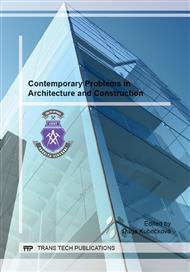[1]
G. Gioda, Indirect identification of the average elastic characteristics of rock masses, in: Proceedings Conference of Structure Foundation on Rock, Sydney, (1980).
Google Scholar
[2]
G. Gioda, S. Sakurai, Back analysis procedure for the interpretation of field measurements in geomechanics, International Journal for Numerical and Analytical Methods in Geomechanics, 11 (1987) 555–583.
DOI: 10.1002/nag.1610110604
Google Scholar
[3]
A. Ledesma, A. Gens, E. Alonso, Estimation of parameters in geotechnical back analysis. I – Maximum likelihood approach, Computer and Geotechnics, 18 (1996) 1-27.
DOI: 10.1016/0266-352x(95)00021-2
Google Scholar
[4]
M. Calvello, R. Finno, Selecting parameters to optimize in model calibration by inverse analysis, Computers and Geotechnics, 31 (2004) 411-425.
DOI: 10.1016/j.compgeo.2004.03.004
Google Scholar
[5]
S. Sakurai, K. Takeuchi, Back analysis of measured displacements of tunnels, Rock Mechanics and Rock Engineering, 16 (1983) 173 –180.
DOI: 10.1007/bf01033278
Google Scholar
[6]
S. Sakurai, S. Akutawaga, Back analysis for tunnel engineering as a modern observational method, Tunnelling and Underground Space Technology, 18 (2003) 185-196.
DOI: 10.1016/s0886-7798(03)00026-9
Google Scholar
[7]
A. Gens, A. Ledesma, E. Alonso, Estimation of parameters in geotechnical back analysis. II–Application to a tunnel excavation problem, Computer and Geotechnics, 18 (1996) 29-46.
DOI: 10.1016/0266-352x(95)00022-3
Google Scholar
[8]
B. Lecampion, A. Constantinescu, D. Nguyen, Parameter identification for lined tunnels in viscoplastic medium, International Journal for Numerical and Analytical Methods in Geomechanics, 26 (2002) 1191-1211.
DOI: 10.1002/nag.241
Google Scholar
[9]
A. Bartoszewicz, P. Srokosz, E. Dembicki, Zastosowanie analizy wstecznej do wyznaczenia parametrów gruntu niespoistego na podstawie wyników badań modelowych, Zeszyty Naukowe Politechniki Śląskiej, seria Budownictwo, 97 (2003) 41-48.
Google Scholar
[10]
S. Levasseur, Y. Malécot, M. Boulon, E. Flavigny, Soil parameter identification using a genetic algorithm, International Journal for Numerical and Analytical Methods in Geomechanics, 32 (2008) 189–213.
DOI: 10.1002/nag.614
Google Scholar
[11]
S. Levasseur, Y. Malécot, M. Boulon, E. Flavigny, Soil parameter identification from in situ measurement using a genetic algorithm and a principle component analysis, Tenth International Symposium on Numerical Models in Geomechanics – NUMOG X, Rhodes, 2007, pp.665-670.
DOI: 10.1201/noe0415440271.ch96
Google Scholar
[12]
Y. Malécot, S. Levasseur, M. Boulon, E. Flavigny, Inverse analysis on in situ geotechnical measurement using a genetic algorithm, Ninth International Symposium on Numerical Models in Geomechanics – NUMOG IX, Ottawa, 2004, pp.223-228.
DOI: 10.1201/9781439833780.ch32
Google Scholar
[13]
M. Dolezalova, V. Zemanova, J. Danko, The Mrázovka exploratory adit-modelling of rock mass mechanical behaviour according to field measurements, Tunel, 8 (1999) 8-14.
Google Scholar
[14]
J. Rott, D. Masín, Back analysis of the earth pressure coefficient at rest in Brno clay on the basis of convergence measurements (in Czech), Geotechnika, 3-4 (2013) 16-21.
Google Scholar
[15]
N.S. Bulycev, N.N. Fotieva, Projektirovanie i pasčot krepi kapitalnych vyrabotok, Nedra, Moskva, (1986).
Google Scholar


